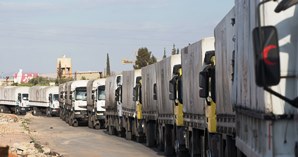 14 March 2016 – 5 years since the conflict began in Syria, millions of people across the country continue to suffer from limited access to basic medical care services because of ongoing conflict and a deteriorating health system. Over 11 million people are in need of health assistance that many hospitals and primary health clinics are unable to adequately provide. More than 4.8 million people have taken refuge in neighbouring countries and beyond.
14 March 2016 – 5 years since the conflict began in Syria, millions of people across the country continue to suffer from limited access to basic medical care services because of ongoing conflict and a deteriorating health system. Over 11 million people are in need of health assistance that many hospitals and primary health clinics are unable to adequately provide. More than 4.8 million people have taken refuge in neighbouring countries and beyond.
In the past week, however, after a fragile cessation of hostilities, access has slightly improved permitting WHO and partners to reach more patients in 10 out of 18 besieged areas. Medicines, vaccines and medical supplies have been delivered through the interagency humanitarian convoys to besieged Madaya, Zabadani Foua, Kefraya; Mouadamieh, Kafr Batna, Ein Tarma, Jisreen, Saqba, and Hammourieh in East Ghouta; and hard-to-reach areas in Aleppo, including Eastern Aleppo, Azzaz and Afrin.
Nonetheless, the supply of medicines and surgical supplies continues to be interrupted. In the case of the recent visit to East Ghouta, antibiotics and chronic disease medicines were subsequently removed from the final list. In 2015, WHO reported 9 incidents of removal from convoy lists of medical supplies destined for Homs, Aleppo, and Rural Damascus governorates. This has deprived more than 140 000 people of vital medical support.
“We urge all parties to the conflict to allow medical and surgical supplies to be included in the humanitarian convoys sent to besieged areas,” says Elizabeth Hoff, WHO Representative in Syria. “When timely access to surgical care is undermined, serious and long-term consequences impact the health of individuals and communities. Without continuous access to basic medicines, people with chronic diseases risk serious complications and death. WHO renews its calls on parties to the conflict to lift the siege, and allow unhindered and sustained access to communities across the country,” Hoff added.
WHO action
Since 2012, the annual number of treatments WHO provided has increased from 1 million to 17.2 million to meet shortages in medicines and medical supplies. In 2015, almost one third (30%) of WHO’s deliveries were to hard-to-reach, opposition-controlled and besieged areas.
WHO is now working closely with 67 nongovernmental organizations (up from 10 in 2012) to help reach more people with primary and secondary health care services, trauma care, essential medicines, surgical and medical supplies and obstetrics services.
More than half of health work force has left because of insecurity. To fill the gap, WHO trained more than 20 000 managers and health workers across Syria in 2015.
In 2012, WHO had set up 100 sites reporting on disease outbreaks; there are now close to 1000 sites, one third of which are reporting from opposition-controlled areas. This system has allowed WHO to monitor and rapidly respond to disease outbreaks and alerts across Syria.
In addition, WHO has established a system called Health Resources Mapping and Availability to report on the status of functionality, accessibility, infrastructure and staffing level of hospitals and health centres throughout the country. To date, the system has expanded to cover public hospitals and health centres, in addition to health facilities managed by WHO-supported nongovernmental organizations. At present, 100% of the 113 public hospitals and 97% of the 1783 public health centres report to this system across the country.
Related link
Life-saving medical supplies reach besieged city in Syria, 2 March 2016
For further information:
Tarik Jašarević
Media Relations
World Health Organization
Mobile: +41 793 676 214
Tel: +41 22 791 5099
E-mail:
Rana Sidani
Senior Communication Officer
Media and Communications
WHO Regional Office for the Eastern Mediterranean
Direct: +20 2 22765552
Mobile: +20 1099756506
E-mail:








